The Bernina Railway
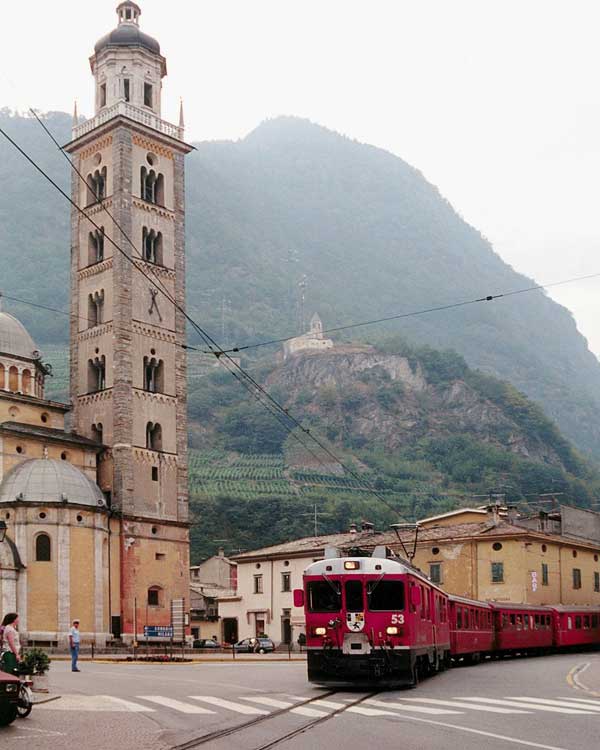
The Bernina railway is a single-track 1,000 mm (3 ft 3 3/8 in) metre gauge railway line forming part of the Rhaetian Railway (RhB). It links the spa resort of St. Moritz, in the Canton of Graubűnden, Switzerland, with the town of Tirano, in the Province of Sondrio, Italy, via the Bernina Pass. Reaching a height of 2,253 metres (7,392 ft) above sea level, it is the highest railway crossing in Europe and the third highest railway in Switzerland. It also ranks as the highest adhesion railway of the continent, and - with inclines of up to 7% - as one of the steepest adhesion railways in the world.
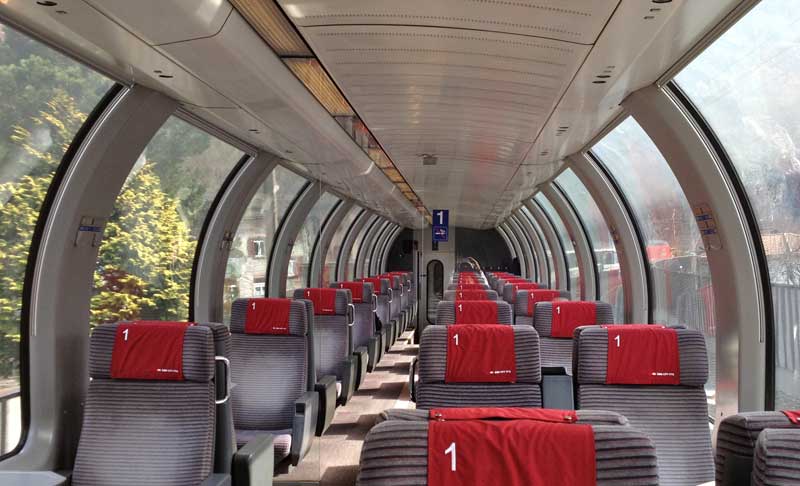
The Bernina Express
The Bernina Express is a train connecting Chur (or Davos) in Switzerland to Poschiavo in Switzerland and Tirano in Italy by crossing the Swiss Engadin Alps. For most of its journey, the train also runs along the World Heritage Site known as the Rhaetian Railway in the Albula / Bernina Landscapes.
The train is operated by the Rhaetian Railway company for the purpose of sightseeing. It takes the form of an enhanced regional service between Tirano and Chur or Davos: panoramic coaches with enlarged windows and multi-lingual (English, Italian and German) audio guide on board. It is not an express in the sense of being a high-speed train; passengers must make a seat reservation either directly when they purchase Bernina Express tickets, or pay a small supplement on top of their regional train tickets. The Bernina Express is popular with tourists and connects in Tirano with the Post Bus service via Lake Como in Italy to Lugano in Switzerland.
The Albula line and the Bernina line on the Bernina Express's route were jointly declared a World Heritage Site in 2008. The trip on the Bernina Express through this World Heritage Site is a four-hour railway journey across 196 bridges, through 55 tunnels and across the Bernina Pass at 2,253 metres above sea. The entire line is 1,000 mm (metre gauge) and electrified.
The Albula line was constructed between 1898 and 1904; it has been operated by the Rhaetian Railway since its auguration. The Bernina line was built between 1908 and 1910 and operated independently until the 1940s, when it was acquired by the Rhaetian Railway. The Bernina Express uses gradients of 7% to negotiate the difference in height of about 1800 meters from the summit at Ospizio Bernina to Tirano.
During the summer, the Bernina Express comprises a special separate train that travels from Chur to Pontresina with very few stops. In Pontresina, the locomotive is changed (because of the Bernina line's different electricity current) and the train continues with few stops to Tirano.
During autumn, winter and spring, the Bernina Express comprises several cars that are attached to regional services. From Chur to Samedan, they are part of a RegioExpress train Chur - St. Moritz; from Samedan to Pontresina, they are part of a Regio train Scuol-Tarasp - Pontresina; from Pontresina to Tirano, they are part of a Regio train from St. Moritz - Tirano. Each of these Bernina Express trains includes designated carriages for passengers with only regional train tickets.
The Bernina Express
The Bernina Express train connects Chur (or Davos) in Switzerland to Poschiavo in Switzerland and Tirano in Italy by crossing the Swiss Engadin Alps. Most travel magazines and websites list this as the most scenic railway journey in the world and we were given no reason to question their judgement. Prehps only the train ride through the Canadian Rocky Mountains would be on a par with what passes by outside the windows of this magical train ride. Once you cross the border into Switzerland, ust about every minute is stunning. Passengers are treated to a smorgabord of alpine scenery - snow-capped peaks, deep valleys, pretty towns, mountain lakes, plunging waterfalls, glaciers.
The first leg of the journey is on a regional train from Milan to the town of Tirano, which is two hours by train, and right on the border of Switzerland where the Bernina Express train terminates. The train journey is very picturesque and passes along the shores of Lake Como on its way up the mountains. Lake Como has been a popular retreat for aristocrats and wealthy people since Roman times, and a very popular tourist attraction with many artistic and cultural gems. It has many villas and palaces and many famous people have or have had homes on the shores of Lake Como, such as Matthew Bellamy, John Kerry, Madonna, George Clooney, Gianni Versace, Ronaldinho, Sylvester Stallone, Julian Lennon, Richard Branson, Ben Spies, and Pierina Legnani.
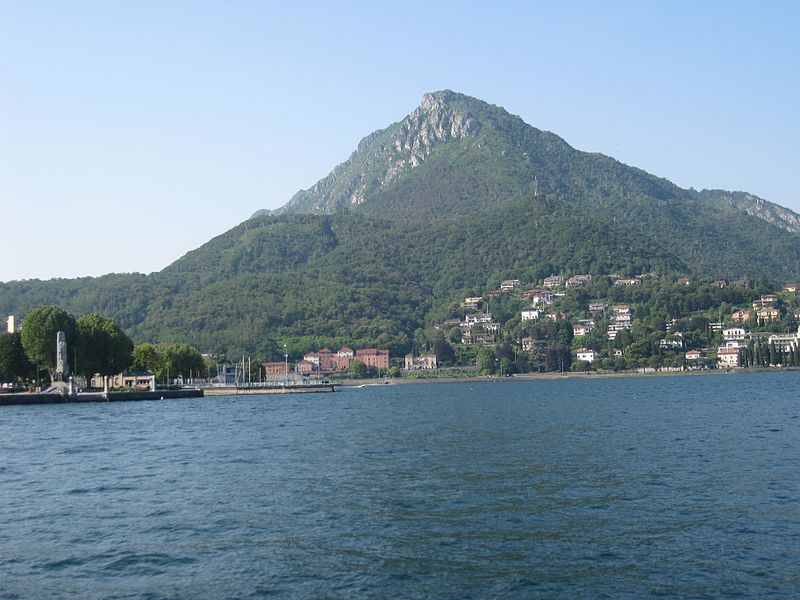
Lake Como
Once Lake Como is left behind, the railway line follows the Adda River valley past farmlands, vineyards, orchards and numerous town on the river plains or clinging to the hillsides. Tirano itself is a pleasant town that is a service centre for the local agricultural region though in recent times it has become the stepping off point for the picturesque Bernina Pass railway. It's a pretty place located in a beautiful mountain setting, and runs very much at its own pace. Snow covered peaks in the distance form the perfect backdrop for the hillsides with terraced vineyards that surround the town. We recommend allowing an hour or so to wander around the town before heading off up the mountains of Switzerland.
The second leg of the journey is the trip aboard the Bernina Express from Tirano to St. Moritz. The Bernina Express is one of the most spectacular ways to cross the Swiss Alps. Along the way, it traverses the 65-meter-high Landwasser Viaduct, the signature structure of the Rhaetian Railway and the UNESCO World Heritage site. Altogether the train passes through 55 tunnels and over 196 bridges on its way to the top of the Bernina Pass. Travellers are treated to marvellous sights during their journey, like the Montebello curve with a view of the Bernina massif, the Morteratsch glacier, the three lakes Lej Pitschen, Lej Nair and Lago Bianco, the Alp Grum and the Brusio Circular Viaduct.
By the time you finally leave the string of towns to the north east of Tirano behind, the rugged, snow capped mountains all around become the main focus of the journey. Waterfalls, glaciers and a mix of evergreen and deciduous trees (the latter were shedding their autumn leaves on our last trip) surround you, though the latter all but disappear by the time the train reaches 2,000 metres and the village of Ospizio Bernina, which has given the train its name. Every twist and bend, every bridge and tunnel reveals a vista different to any you have seen on the journey thus far as the narrow gauge train climbs its way to the top of the Bernina Pass, 2,256 metres (7,406 feet) above sea level. From there the line begins its long, winding way down the other side past some of Switzerland's most popular ski resorts and ski runs.
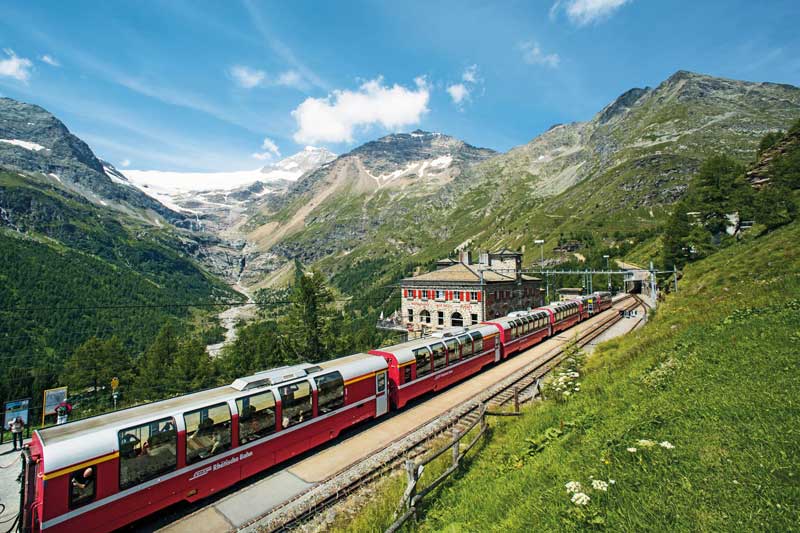
Pontresina station
The journey from Tirano to St Moritz takes around two and a half hours. If you would rather keep going all the way to Zurich, Switzerland, you will need to take a train from Tirano to Chur, rather than St Moritz. It goes almost as far as St Moritz, but turns off before reaching the alpine village, and continues north, stopping at Poschiavo, Pontresina and Samedan. The journey from Tirao to Chur takes between 4 and hours, depending on how many station the train stops at. From Chur, there is a regional train to Zurich (1 hr 1 mins to 1 hr 43 mins).
What travellers along this incredible route are rarely told is that as well as the Bernina Express, ordinary domestic Swiss trains also service the towns on the route. Both trains are airconditioned, take the same amount of time to make the journey and apart from lacking an audio commentary, the only difference appears to be the price. And if you are travelling on a Eurail Pass, travel on the local train is included in the Pass at no extra charge. Being a local train, there is no need to book in advance, you just climb aboard with your rail pass, sit back and enjoy the ride.
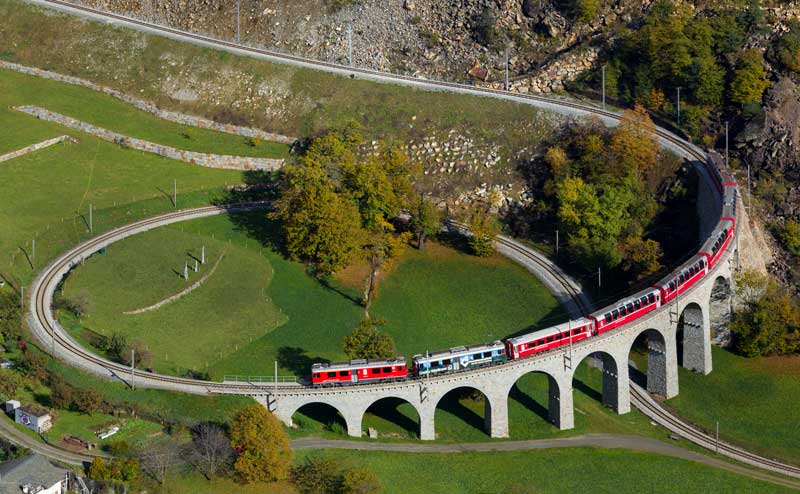
Berina Express Day Tour
An alternative to doing the whole journey totally by train is to take an organised tour which includes travel both on the train and a coach. The tour begins with a coach ride to Tirano via Lake Como where it stops for breakfast, having left Milan early in the morning. Upon arrival in Tirano, guests have an hour and a half to enjoy Tirano and have lunch before boarding the Berina Express to St Moritz.
There is around an hour to look around St Moritz before a coach takes guests back to Milan via a different route, which includes traversing the Maloja Pass. With the road twisting and turning its way down the hillside with barely room for cars to make the tight hairpin bends, not to mention a giant coach, the 3 hour dive down to Milan is as memorable as the journey up was a few hours earlier.
The Journey: St Moritz to Tirano
St Moritz is the terminus of both the Albula Railway and the Bernina Railway. As the two railways are powered by different electrification systems, they meet at the same station, but operate on separate lines from separate platforms. The Bernina Railway leaves St Moritz station in an easterly direction, and crosses the Inn River on a 64 m (210 ft) long viaduct. It then passes through the 689 m (2,260 ft) long Charnadűra-Tunnel II, the longest tunnel on the entire route. The next station, Celerina Staz, is, at 1,716 m (5,630 ft) above sea level, the lowest point on the north side of the Bernina Pass. From there until Ospizio Bernina, the line will now climb almost continuously. After returning to the banks of the Inn, the line reaches the small station Punt Muragl Staz. At this point is the valley station of the funicular to Muottas Muragl, opened in 1907.
The next station in Pontresina represents, together with St Moritz station, a curiosity in the network of the RhB: two completely different electrification systems meet here. The 11 kV AC powered trains, which enter the station on the line from Samedan, use tracks 1 to 3, while the 1,000 V DC powered Bernina trains use tracks 3 to 7. Track 3 has a catenary that can be switched from alternating current to direct current, and a special signal to display to train crews the type of current being used. By means of track 3, the trains using the core network (from Samedan) and the Bernina line trains can use the same line, despite their differing electrification systems. On track 3 is also the exchange of locomotives for the famous Bernina Express, which operates between Chur or Davos Platz and Tirano.
The line now turns to the south east. After crossing the Rosegbach, passing through the Surovas station (which was previously called "Sans Souci" (Carefree), and crossing the Berninabach, it finally reaches Morteratsch station, about 2 km (1.2 mi) below the Morteratsch Glacier. Past the other end of the station is the world famous Montebello Curve, where the line meets the road over the pass. The line and the road will now accompany each other as far as Ospizio Bernina. At the recently modernised Bernina Suot passing loop, the tree line has already been reached. The next stations are Diavolezza and Bernina Lagalb; both are departure points of cableways.
The next section is probably the most interesting on the north side of the pass. Here, the route is very winding, and moves from one side of the valley to the other. First, the Berninabach is crossed, using the 37 m (121 ft) long Lower Berninabach Bridge, and then the line crosses the Arlasbach, a tributory of the Berninabach. On the Upper Berninabach Bridge, the line moves back to the eastern side of the valley. Southwest of here, the Piz Bernina and the Piz Palu rise majestically. Next follows the 175 m (574 ft) long Arlas Gallery, which provides protection against snow drifts. On the southwestern side are the small lakes known as Lej Pitschen and Lej Nair. Directly behind them towers the 15 m (49 ft) high and 283 m (928 ft) long Lago Bianco dam, which also marks the watershed between the Danube and the Po.
The railway now runs along the eastern bank of the lake, and, near Ospizio Bernina, reaches its highest point, at 2,253 m (7,392 ft) above sea level. The Bernina Railway is thereby (mountainside railways excluded) the highest railway line in the Alps, operating as a public railway with year round traffic. As the section from here to Poschiavo is particularly badly affected by drifting snow, countless engineering structures have been erected from the southern dam wall onwards: the 140 m (460 ft) long Scala Gallery, the 192 m (630 ft) long Scala Tunnel, the Sassal Mason Gallery, even longer at 348 m (1,142 ft), and the 54 m (177 ft) long Drago Tunnel.
After the Grűm Gallery, the attractive Alp Grűm station is reached. It not only is located at the tree line, but also marks the last station before the Italian linguistic border. From here onwards, the line clambers, with a gradient of up to 7%, and via multiple s-bends, downwards into the Poschiavo valley. That this occurs without the assistance of a rack railway system makes the Bernina Railway one of the steepest adhesion railways in the world.
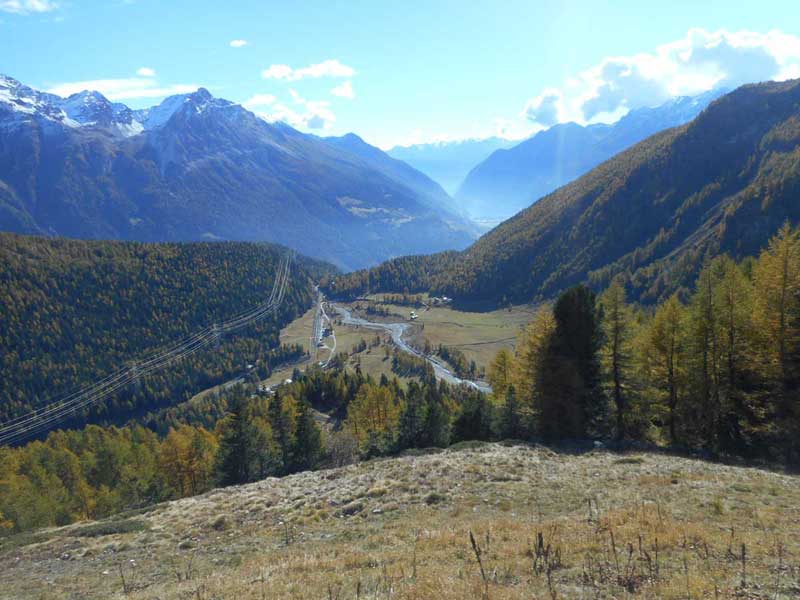
Immediately behind the Alp Grűm station, the line winds in a tight 180 degree bend, and passes below Alp Grum through the Upper Palu Gallery. In a further 180 degree bend, it heads through the Palu Tunnel and subsequently through the Lower Palu Gallery. A further four half circle loops follow, until the line reaches the Cavaglia station. Since about 2000, there has also been a new automatic passing loop, Stablini, between Alp Grűm and Cavaglia. It bisects a portion of the line that was previously prone to traffic delays. In zigzag fashion, the line continues from Cavaglia further down into the valley via Cadera to Privilasco. From there, the line leaves the tight bends behind, and, still at its maximum gradient, reaches the Poschiavo Valley. In Poschiavo it finally meets up once again with the Bernina Pass road.
At the request of the Poschiavo community, the station at Poschiavo was built just outside the village boundaries. It has a railway depot and workshop, in which a few historic railcars of the Bernina Railway are also stored. The remaining section of line of approximately 17 km (11 mi) to Tirano are laid partially still as a mountain railway, but also partially in the manner of a tramway system. After the stopping point Li Curt, erected only in 1977, the line ends on a street in the village of Le Prese. Between Le Prese and Miralago the line passes along the banks of the Poschiavo Lake, thus remaining at the lake's altitude of 965 m (3,166 ft) above sea level.
Below Brusio, the railway has, as its last highlight, the Brusio spiral viaduct, which serves only to adjust the altitude of the line. The spiral viaduct is followed by the stopping point for the village of Campascio, which still belongs to Brusio. Beyond the border station of Campocologno, which is unusually large due to its customs facilities, the line finally reaches Italy, and, after crossing the main square of Tirano, its terminal station. Here, the Bernina Railway meets the standard gauge station and line of the Italian state rail infrastructure company Rete Ferroviaria Italiana (RFI), which links Tirano through Valtellina to Milan.


